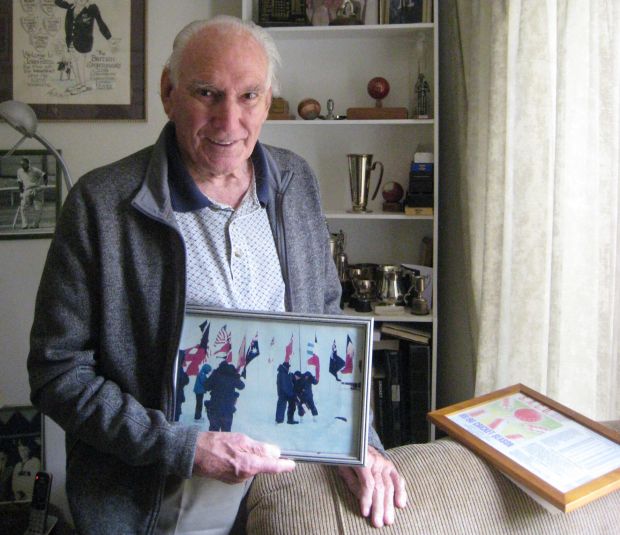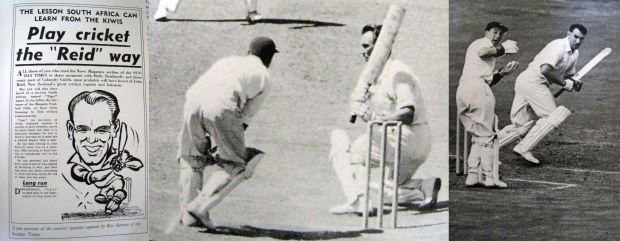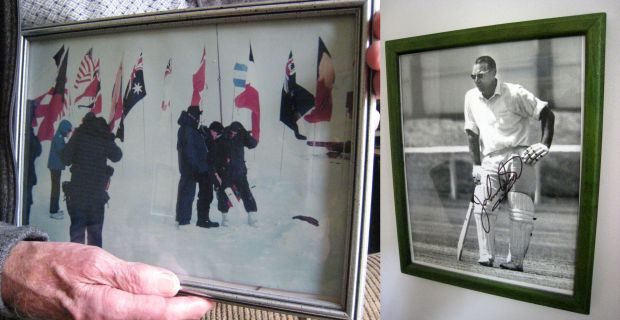
John Reid in his study surrounded by memorabilia from his cricketing career – Image taken by Lisa Thompson
“We weren’t professionals you see. There was no such thing as a professional in those days.”
– John R. Reid
Listen to an extended version of the interview
New Zealand and England have been competing against each other in Test Cricket since 1929. To date, the two sides have played 99 tests, with England winning 47, New Zealand eight and 44 drawn. And while the two sides have keenly contested recent Tests, it hasn’t always been the case.
On March 28 1955, England (then known as the Marylebone Cricket Club) bowled New Zealand out for 26 in their second innings at Eden Park in Auckland. It has been described as our ‘darkest day’ in cricket and it is a score that still stands today as a record test low.
For former New Zealand batsman and bowler John Richard Reid, looking back sixty years to that day is something he says he’d rather avoid. “Do we have to go round to that? I didn’t think we’d get bowled out for 26. Can I whisper that?” he says with a chuckle. “I don’t remember much else and I don’t want to remember much else either!” However, his twinkling eyes tell otherwise and rafts of memories are soon revealed.
Fresh from winning the 1954-55 Ashes series against Australia, England travelled to New Zealand with a formidable team. Amongst the players was Frank “Typhoon” Tyson, who at the time was regarded as one of the fastest bowlers ever seen in cricket.
John Reid says the New Zealand players had never seen the like. While New Zealand posted a competitive score in the first innings of 200, anchored by 73 from Reid, and held England to a lead of only 46, they were laid bare in the second. “I had problems with Tyson… the first ball I faced him I had my bat going back and the ball went past me…I was not out overnight but the morning of the next day I had guys throwing it at me from halfway down the pitch to quicken up my reactions.”

Left: A cartoon of John Reid that appeared in the Sunday Times newspaper. Middle: John Reid sweeping a ball to the boundary in a game against Western Province in South Africa. He scored 25 fours in that match, and made 203. Right: Yet more runs coming from John’s bat – Images courtesy of John Reid.
Another player who tormented the New Zealanders was Bob Appleyard, who took four for seven in the second innings and seven for 45 for the match. “We knew they were a good side… top rated players. We just had to go out and do as best we could,” John says. “But we weren’t used to it because we’d play club cricket, representative cricket and then a gap as they’d come over in March sometime and our season would have finished end of January. Then we’d have a touring team with the fastest bowlers in the world!”
And in between the team would hang up its whites and go back to their day jobs to earn a living. However, despite the dismal performance, John says the New Zealand public did not give the team a hard time about their performance.
And the following year, they were rewarded for their support. In 1956, John Reid captained the New Zealand team to their first test victory against the West Indies. “There was a lot of runs on our side… but the big thing was that we got Everton Weekes out. It wasn’t a Mickey Mouse side but we had a pretty good performance indeed… after that we started climbing up the ladder!”
Archival audio supplied by Ngā Taonga Sound & Vision.
John R. Reid’s cricket career
 John Richard Reid was born in Auckland, New Zealand in 1928. Having been named in his high school’s First XV every year since third form, Reid was on track to become a top rugby player from an early age, describing the game as his ‘first love’. However, after spending four months in hospital with rheumatic fever at the age of 18, doctors told John to stop playing rugby, dashing any further hope John had of participating in the sport.
John Richard Reid was born in Auckland, New Zealand in 1928. Having been named in his high school’s First XV every year since third form, Reid was on track to become a top rugby player from an early age, describing the game as his ‘first love’. However, after spending four months in hospital with rheumatic fever at the age of 18, doctors told John to stop playing rugby, dashing any further hope John had of participating in the sport.
Luckily, John was just as handy with the cricket bat and gloves, and started wicket keeping. He was selected as a wicket keeper/batsman but gave wicket keeping away for bowling. “I wanted to be a batsman who could bowl, which is what I ended up doing,” John says. Having scored two centuries during selection matches, John was picked at the age of 20 for the New Zealand Test side by Walter Hadlee, who saw him as a “possible up and comer”.
Image: A cartoon commemorating John’s career – Image courtesy of John Reid.
John made his debut during New Zealand’s tour of England in 1949, scoring a half-century in the first innings of the third test at Manchester. In 1956, John Reid captained the New Zealand team to their first test victory against the West Indies. He reached his full powers as a batsman on New Zealand's tour of South Africa in 1961–62, when he led New Zealand to their first away-test win, and set a record aggregate for a touring batsman with 1,915 runs and seven centuries.
John Reid played a total of 58 tests for New Zealand between 1949 and 1965 and on retirement from first-class cricket, he had scored a total of 3,428 runs at an average of 33.28. He had also taken 85 wickets at an average of 33.35. Later he became an ICC match referee and controlled 50 tests and 90 one-day matches.
John Reid received an OBE in 1962 and became a Companion of the New Zealand Order of Merit (CNZM) in 2014, cementing his place as one of New Zealand’s greatest all-round cricket players.

Left: A close-up of the picture John’s holding. It shows John playing in what is thought to be the first cricket match at the South Pole in 1969. The game ended when John hit a six and the ball was unable to be found in the snow – Image taken by Lisa Thompson. Right: Waiting for some action at the crease – Image courtesy of John Reid.


